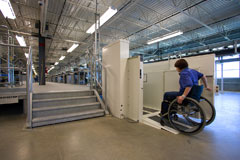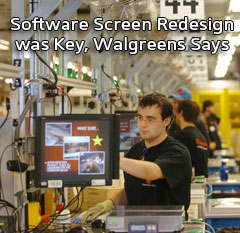Assess Each Candidate Individually
 In conjunction with the local partner, candidates are identified to each Walgreens DC. Candidates cannot be forced, of course, to disclose their disability, though most do. In conjunction with the local partner, candidates are identified to each Walgreens DC. Candidates cannot be forced, of course, to disclose their disability, though most do.
“Everyone thinks about person with disabilities as being in a wheelchair, but there are lots of disabilities,” Lewis said. “The person with one arm, the person with some (but limited) mobility, vision problems, cognitive disabilities – there are a thousand disabilities before you get to someone in a wheel chair.”
“You look at someone’s skills or their ability, and you match them to the right job, just like you do for a person without disabilities,” Scarbrough added.
Don’t Necessarily Think “Universal Access” throughout the DC
Lewis said that early on Walgreens decided not to try to achieve so-called “universal access” that would allow disabled employees to move and work anywhere in the building.
Such an approach might entail significant costs, “and we were looking for a sustainable model,” Lewis said. “We had to make decisions on what we would not be able to accommodate.”
This, of course, in practice, means that some disabled workers cannot get to certain areas to do certain jobs, but this has really not had a major impact of any kind on the success of the program, and empowered it by keeping investment costs modest, even as some disabled advocates pressed for universal access.
In some cases, however, Walgreens has made additional accommodations, such as adding a lift up to a mezzanine. In other cases, it takes a pragmatic approach – if a wheelchair needs lifted and moved to get someone into the right place, that’s simply what the DC team does.
In a couple of cases, Walgreens has had to add some more handicapped parking based on the number of employees with permits, but Russell said they have had no complaints from other workers that they were “losing parking spaces” or any other issues.
Processes Really Don’t Change that Much
When the Anderson DC was being designed, the first consideration was building the most efficient building and processes first, Lewis said. Then, they looked at places where they might make some modest changes to accommodate the disabled – but, in the end, that usually wound up being to the benefit of the entire process.
“The accommodations we made in the design in general made it better for everybody,’ Lewis said. “When you reduce how much you have to reach, how much you have to bend over, it helps everyone’s productivity.”
He said the biggest accommodations probably related to “paper and pencil,” meaning some changes to job training.
“This is really not that hard,” Lewis said. “You just have to assess what each person needs.”
He said that in existing buildings, the program is being successful despite no real physical accommodations for the disabled in those DCs.
Software Re-Design was Key
Software (WMS, WCS, etc.) plays a critical role in most high throughput distribution centers. To make its DC operations more accessible to disabled workers, Walgreens needed to rethink the design of its existing software systems.
“We needed to make the screens simpler, get rid of keyboards where we could, use symbols instead of words wherever possible,” Lewis noted.
“Existing computer screens and interfaces are probably the biggest barriers to employing the disabled,” Scarbrough added.
The interesting side benefit is that such changes can actually improve usability even for non-disabled associates.
Disabled Can Do Almost Any Task
Scarbrough said that in the Anderson DC, “Every department in the building has someone with a disclosed disability working successfully, and across shifts.”
That even includes fork truck drivers.
“We might have someone with limited mobility driving a lift truck, or even a cognitive disability,” Sylvester said of the DC in Connecticut.
The goal of the program, Lewis said, is to fully integrate the disabled in every way into DC operations.
“They are working side by side with the non-disabled, have the same pay, the same jobs, the same standards,” he said.
“In truth, we even limited ourselves early on in our thinking about where the disabled can work,” Lewis added. “It’s easy to sell them short.”
Biggest Obstacle is Perceptions
Walgreens says that there were not really any significant legal or regulatory barriers to moving ahead with the program – the biggest obstacle for them or any company is likely to be internal perceptions in the company.
“People were worried we were going to have more accidents, insurance was going to go up, non-disabled people wouldn’t want to work around people with disabilities, things like that,” Lewis said.
Just the opposite turned out to be the case, he said: accidents and costs have actually decreased, and it has created more of a sense of teamwork.
“We found all the prejudices to just not be true,” Lewis added.
A Few Unexpected Challenges
Companies pursuing such a program will undoubtedly find some unexpected challenges, Walgreens says.
 One it ran into had to do with “bidding” for new job openings. In general, workers often start out on night shifts, and bid to get the more desirable first-shift openings when a spot opens up. One it ran into had to do with “bidding” for new job openings. In general, workers often start out on night shifts, and bid to get the more desirable first-shift openings when a spot opens up.
However, many disabled workers cannot arrange transportation outside of normal business hours. That meant that the program might be torpedoed, because as there was turnover among the disabled workers that started out in the new Anderson building, bids would be won by non-disabled workers on the off shifts; eventually, there would be few disabled workers at all.
So, Walgreens created some non-biddable positions.
While Lewis says that did create some concerns that the approach was not “fair,” in the end, it was recognized as being essential to achieving its goals with the program. He also said that while you can’t “discriminate” in most circumstances against the disabled, you can, in fact, do so against the able-bodied. In the end, the non-biddable positions approach has worked well, Lewis said.
Incentives May Be Available
While the potential for financial incentives to hire disabled workers was not at all a factor in terms of the decision to go ahead with the program, Walgreens says there may be some available incentives to increase the benefits of the move.
“There are tax credits for companies that employee people that fall within six different categories of disabilities,” Russell said. She also said that there is a program called “Ticket to Work” that provides incentives for awhile when a company hires someone who then moves from receiving Social Security benefits to being independent. There may also be individual state programs.
However, Russell says some of these incentive programs are growing more complex, and may not be worth the effort.
“We’re focused on employing people, not dealing with the bureaucracy,” she said.
Management Gets More in Touch on the Floor
While the approach of DC managers and supervisors needs to change in some ways with this type of program, those changes are nothing but positive, the Walgreens team says.
 “It only makes you a sharper leader overall,” Sylvester said. “The reason I say that is that you work with every individual to find their niche, the best fit for each person. I know the managers at Walgreens know their people better than in any other DCs we’ve been in.” “It only makes you a sharper leader overall,” Sylvester said. “The reason I say that is that you work with every individual to find their niche, the best fit for each person. I know the managers at Walgreens know their people better than in any other DCs we’ve been in.”
Scarbrough added that “You have to be creative in finding out what is going to motivate each person. That creativity has carry-over benefit to our work with non-disabled employees, our carriers, vendors and other partners. It’s a win for everyone.”
You Have to Take Action if it Just Can’t Work Out
Hiring the disabled doesn’t mean you have to keep every employee regardless as to how they are performing – in fact, building the program with the capability to determine it just can’t work for some hires is essential for the total program’s success.
In the end, Lewis says the program has had a neutral impact on productivity (it has remained the same), and that the benefits overall have far outweighed the investment, which has mostly been in management time and attention to the program, plus the software modifications.
“We have better teamwork, fewer accidents, less turnover, and management that is much more engaged,” Lewis said. “Just as important, we have a sense of purpose, and there is a halo effect around the whole logistics division in terms of what we are accomplishing.”
“This is one of the best things we have ever done,” he added.
What’s your reaction to the Walgreens’ program? Should more logistics organizations be pursuing this path? What concerns – real or perceptual – do you think managers and employees would have? Let us know your thoughts at the Feedback button below.
SCDigest is Twittering!
Follow us now at https://twitter.com/scdigest |